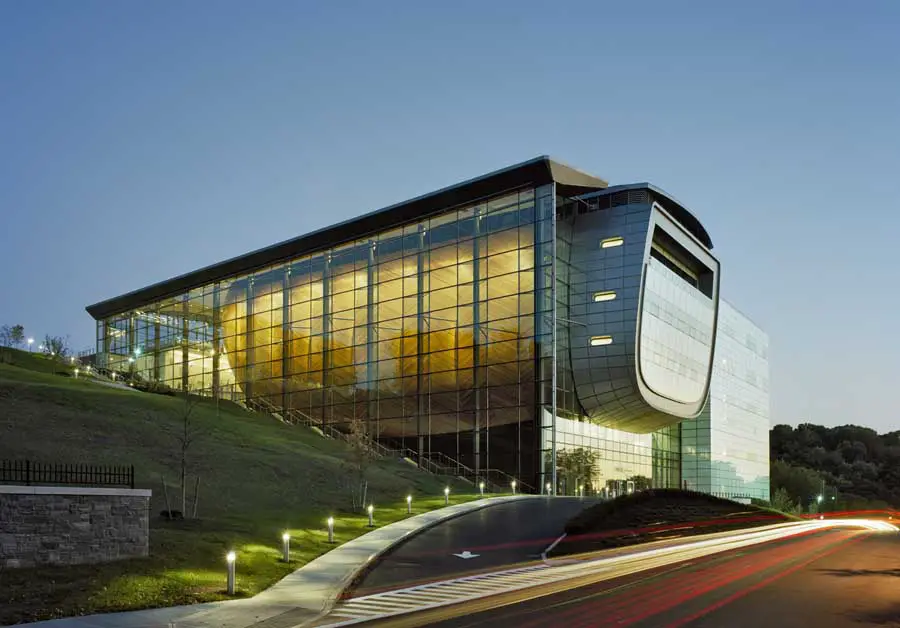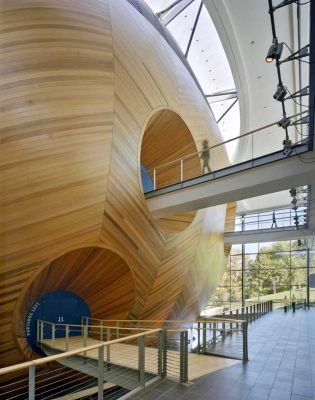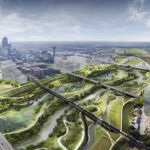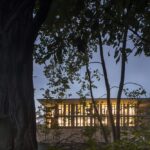Experimental Media and Performing Arts Center, Troy building images, Architect, American Concert Hall
EMPAC Troy, New York Architecture
Rensselaer Polytechnic Institute, NY, USA, design by Grimshaw Architects
Feb 20, 2009
Location: Performing Arts Centre – EMPAC, Troy, New York State, USA
Date built: 2008
Design: Grimshaw
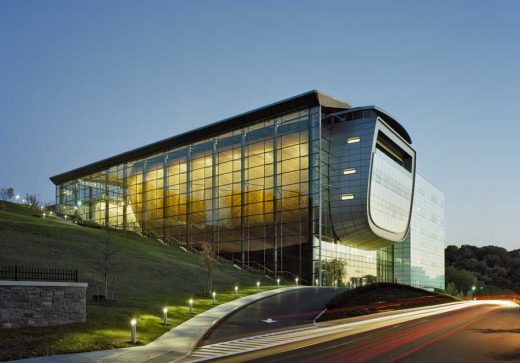
photograph : Paul Rivera/archphoto
eMPAC
Experimental Media and Performing Arts Center
Client: Rensselaer Polytechnic Institute Troy, New York
Project Description
Creation of a building custom-designed for Rensselaer’s new Experimental Media and Performing Arts Center. eMPAC offers an ambitious, international artistic program, which provides opportunities for interaction and exchange between artists and researchers in science and technology.
The eMPAC building incorporates a wide variety of venues designed to the highest professional standards, which accommodate both the traditional performing arts and new, experimental media. Also provided are artist-in-residence studios; audiovisual production and postproduction suites; audience amenities; and student and support facilities. All program areas, including the atrium, are designed to performance standards.
All venues throughout the building are wired to the production and postproduction suites, which can receive sounds and images from every part of the building and can transmit sounds and images in turn. Located on the edge of the Rensselaer campus overlooking the city of Troy, eMPAC is meant to serve the campus, audiences throughout New York State’s Capitol
Region and the Berkshires, and the international arts community.
Principal Design Concepts
Tradition/Experimentation: The eMPAC program Concepts poses a question—how to combine, in one building, the permanence of the traditional performing arts with the necessarily transient character of experimental media. As one of their starting points, Grimshaw considered the resonant chambers of stringed instruments, in the belief that tradition and experimentation are linked by the unvarying physics of sound.
So that the traditional and the experimental may be seen as yoked together yet distinct, Grimshaw arranged the concert hall and atrium axially with the main entrance in a linear sequence on the north side of the building, while the studios and theatre form an adjacent sequence on the south. A conceptual dialogue was then initiated between these two sequences by seeing the concert hall manifested as the physical presence of an object in space, while the theater and studios represent the physical absence of discovered voids within a solid.
Concealment/Exhibition: By taking advantage of the slope of the hillside site, the design solves one of the persistent challenges of performing arts projects: concealing the windowless mass of a very large hall and fly tower. This use of the topography also creates vistas over Troy toward the Hudson River, as seen from the campus approach and from major visitor spaces within the building.
Found Space: Because the main entrance is at hilltop level, close to the roof, while the volume of the concert hall is fitted into the slope below, a large ‘found space’ opens up between the two. Upon entering the building, visitors find themselves at the top of the atrium and main circulation area, looking down at the exterior of the concert hall: a curved wooden hull made of solid cedar planks. Access to the concert hall is provided via elevated walkways that span like gangplanks across the atrium. The entire hull of the concert hall is contained within the atrium, allowing public circulation all around it.
Transparency: The entire north facade of the building is a glass curtain wall, providing transparency between the eMPAC interior and the city of Troy. The glass wall allows daylight to flood the atrium, augmented by a halo skylight around the top of the concert hall that washes the cedar hull with the changing light of the day. By night, the wood hull is lit up from within the building and creates an iconic external identity that can be seen from distance.
Acoustic Isolation: As many as two dozen spaces in the building, all built to first class acoustic standards, may be in use simultaneously. To allow this to happen without acoustic interference, the major venues are distributed in a cascading arrangement on the site to increase isolation and are constructed with separate foundations, complex independent superstructures and resilient isolation.
Concert Hall
Designed to be a first-class venue for symphonic music, yet equally capable of accommodating jazz, amplified music, presentations, film and dance with electronically generated sound and video projection, the concert hall is configured traditionally in the “shoe box” format, as a long, narrow room of wood and masonry construction. The floor, and lower walls are all finished in maple, whilst the upper walls are clad in a combination of precast acoustic panels made of gypsum and precast stone. The room is slightly convex in form, for acoustic diffusion.
The fixed audience seats in EMPAC are custom-designed by Grimshaw and optimized for ergonomics and acoustics. A folding maple “clamshell” forms the seat and seat back, with leather upholstered cushions.
The ceiling, which is the most innovative feature of the concert hall, is made of panels of fabric less than one millimeter thick, supported on a delicate web of stainless steel cables. The fabric was specially selected and woven for EMPAC and is optimized for gentle reflectivity to high-frequency sound and increasing transparency to mid- and low-frequency sound, providing acoustic support to the musicians and audience while allowing the volume above the ceiling to generate reverberance. The ceiling panels form a convex shape overall and exhibit a gently glowing surface when illuminated.
Theater
With a 40’ x 80’ stage and a 70’ flytower complete with computer-controlled rigging, the theater is equipped to the highest standards available to professional theater companies and offers an extraordinary resource for Rensselaer’s experimental artists and student performers. The theater can be used with or without its orchestra pit.
Movable seating at parterre level, along the sides, allows artists to configure the theater as a proscenium space or to extend the playing area along the sides of the audience. The framing of the side galleries accommodates the attachment of projection screens and loudspeakers, allowing the audience to be immersed in virtual environments. Finished with maple floors and high-quality plaster walls, the theater has a slightly less formal treatment than the concert hall, so that its architectural presence can recede when the stage lights come up.
Studio 1:
A true “black box” venue with minimal architectural finish, Studio 1 is well suited for audio and music but is optimized for scientific visualization, multi-screen and immersive performances, and dance. The immediate physical space can all but disappear; with video projection taking place on all sides beneath a 40’ ceiling that features a walkable theatrical grid over the entire surface of the room. The floors are of resilient wood, painted matte black. The walls are composed of adjustable acoustic wall diffusion panels, also matte black.
Studio 2:
Studio 2 is a smaller sibling of Studio 1, and whilst being well suited for dance and visual presentations it is optimized for music recitals and recording therefore has a “lights on” architectural character rather than being a black box. In addition to its tension wire grid ceiling, Studio 2 is finished with a resilient maple floor and ivory colored adjustable acoustic wall diffusion panels.
EMPAC Troy – Building Information
Client: Rensselaer Polytechnic Institute
Contract Value: US$140m
Area: 19,120 sq m/ 202,000 sqft
Status: Under construction
Design Start Date: 06/2001
Site Start Date: 01/2004
Completion Date: 10/2008
Performing Arts Centre – EMPAC Troy images / information from Grimshaw
EMPAC Troy Building : Further Information
EMPAC Troy design : Grimshaw, London, UK
Location: Troy, New York State, USA
American Buildings
Contemporary Architecture in USA
New York Architecture – Manhattan
EMPAC Troy architect : Nick Grimshaw
New York State Architecture Designs
Bubble Shade
Design: Valerie Schweitzer Architects
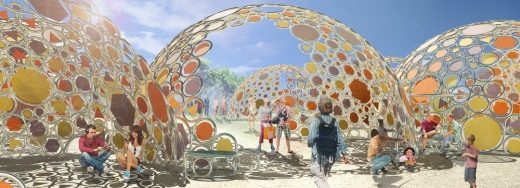
image © Valerie Schweitzer
NYC Parks Bubble Shade
Tammany Hall Redevelopment, 44 Union Square, Manhattan
Renewal design: BKSK Architects
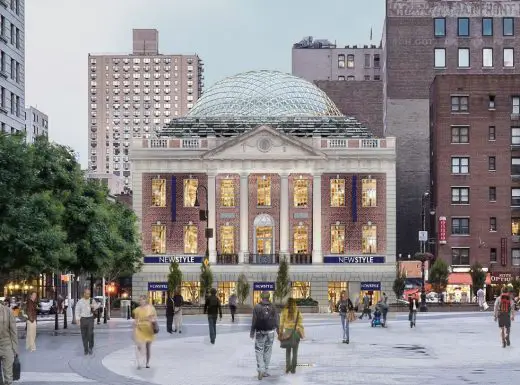
rendering Courtesy of Newmark Knight Frank
Tammany Hall Building Refurbishment
World Trade Centre New York building
Buildings / photos for the EMPAC Troy – Rensselaer Polytechnic Institute building design by Grimshaw Architects page welcome.

